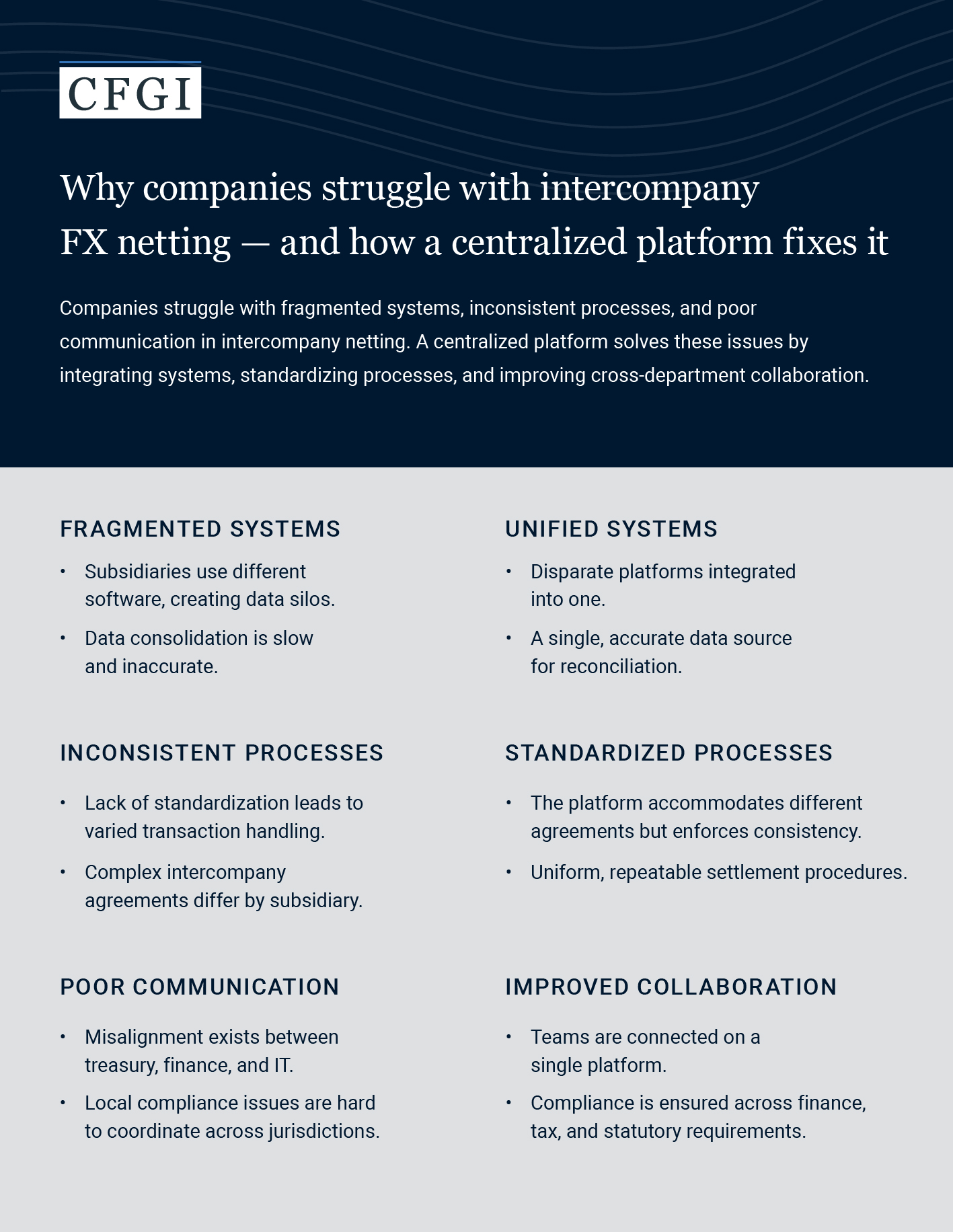For multinational corporations, managing intercompany transactions in multiple currencies can quickly become a complex challenge. What begins as a collection of routine financial flows – such as internal sales, cost allocations and financing — often evolves into a web of inefficiencies if not properly managed. One global company, for instance, faced rising transaction costs, growing foreign exchange (FX) exposure, and persistent delays in cash flow reconciliation. The underlying issue? A lack of a cohesive approach to intercompany netting.
Without an effective system in place, subsidiaries operating across different countries, currencies, and regulatory frameworks struggle to reconcile payments efficiently. Over time, this complexity compounds, leading to increased transaction and FX costs, missed reconciliation deadlines due to mismatched invoices, and bottlenecks in cash flow from delayed settlements. It’s a story we’ve seen before — a lack of structured netting multiplies small inefficiencies into significant operational challenges. The lesson is clear: By leveraging intercompany netting as a strategic tool rather than a back-office function, companies prevent inefficiencies before they snowball.
Intercompany netting: A preventive solution
At its core, intercompany netting is a financial process that offsets receivables and payables between subsidiaries, reducing multiple payments into a single net transaction. This approach reduces transaction volume, cuts FX exposure, and simplifies cash flow management. Without an efficient netting process, companies face redundant intercompany settlements, leading to delays and unnecessary transaction fees.
However, netting should not be viewed simply as a fix for existing problems — it’s a proactive solution to prevent them in the first place. By consolidating payments and automating the process, companies can avoid the inefficiencies that arise when intercompany FX transactions are managed reactively.
The benefits of implementing netting early in the process include:
- Fewer payments: Consolidating transactions reduces the number of cross-border payments, cutting down on bank fees and transaction costs.
- Lower FX risk: Netting minimizes currency exposure by limiting the number of FX conversions needed across subsidiaries.
- Improved cash flow forecasting: Automating the process provides real-time visibility into cash flows, enabling better financial planning. Manual processes often result in duplicate invoices, creating significant reconciliation challenges.
Why companies fall behind on netting
Despite its advantages, many companies struggle with intercompany netting because it’s often implemented too late, after inefficiencies have set in. Without early intervention, companies face a range of common challenges:
- Fragmented systems: Subsidiaries use disparate financial software, hindering data consolidation and creating reconciliation delays.
- Inconsistent processes: Without standardization, each subsidiary may handle transactions differently, creating a lack of uniformity in how intercompany balances are settled. Complex intercompany agreements often vary by subsidiary, making standardization difficult.
- Poor communication: When treasury, finance, and IT teams don’t collaborate effectively, gaps in the process can lead to missed opportunities for optimization. Managing intercompany netting across multiple jurisdictions requires attention to local finance, statutory, and tax requirements.
These challenges are more difficult to resolve once they’ve become entrenched. The solution lies in implementing a structured netting approach before these problems start to accumulate.
Case study: Engineering efficiency with a centralized netting platform
A global engineering firm illustrates how addressing intercompany netting issues early can transform operations. The company, with over $1 billion in revenue and operations in 16 countries, faced a significant backlog of unreconciled intercompany invoices, many outstanding for more than a year. The complexity of managing multiple currencies, combined with inefficient communication between departments, caused severe bottlenecks.
The company turned to a centralized netting platform to streamline its intercompany processes. This platform enabled single settlements for aged invoices, provided real-time visibility into intercompany balances, and created a repeatable monthly process. As a result:
- Settlement volume dropped, reducing transaction costs and FX exposure.
- Real-time visibility improved cash flow management, enabling more accurate forecasting and timely settlements.
- The treasury team was freed from manual reconciliations, allowing those employees to focus on strategic initiatives.
How to stay ahead: Best practices for preventing problems
This case highlights the importance of addressing intercompany netting before inefficiencies take root. To prevent these challenges from becoming entrenched (and becoming a drain on resources), companies should adopt a proactive approach focused on best practices. Here’s how:
- Start early: Address intercompany netting early to prevent inefficiencies and streamline processes before problems arise.
- Standardize processes: Create uniform procedures for all subsidiaries to handle intercompany transactions, reducing errors and delays in settlement.
- Invest in technology: A centralized netting platform is critical for managing multi-currency, multi-entity transactions. Automate data collection and settlement processes, to achieve real-time visibility into cash flows and improve decision-making.
- Monitor continuously: Even with a system in place, regular monitoring is essential to ensure that the process continues to operate smoothly. Routinely review the company’s netting approach to identify areas for improvement and optimize where needed.
- Facilitate cross-functional collaboration: Have treasury, finance, and IT teams work together to support the netting process. Clear communication across these departments is vital to ensuring that the system functions properly and that any issues are addressed promptly.
The Bottom Line: Preventing problems before they start
Managing intercompany netting proactively is more than just cutting costs — it’s a strategic move that drives operational efficiency and financial control. For many companies, what starts as a practical cost-saving measure evolves into a powerful tool for transforming their entire financial ecosystems. Early adoption helps avoid common pain points, saving money, improving cash flow visibility, and reducing FX risk.
Companies that recognize the warning signs early can prevent inefficiencies from taking root. By viewing intercompany netting as a preventive strategy rather than a reactive fix, businesses can streamline their financial processes, reduce risks, and enhance overall cash flow management. Taking early steps to implement intercompany netting not only mitigates potential risks but gives you the ability to respond quickly to market changes. Companies that adopt these best practices position themselves to make fast, informed decisions based on real-time data cash flow.

